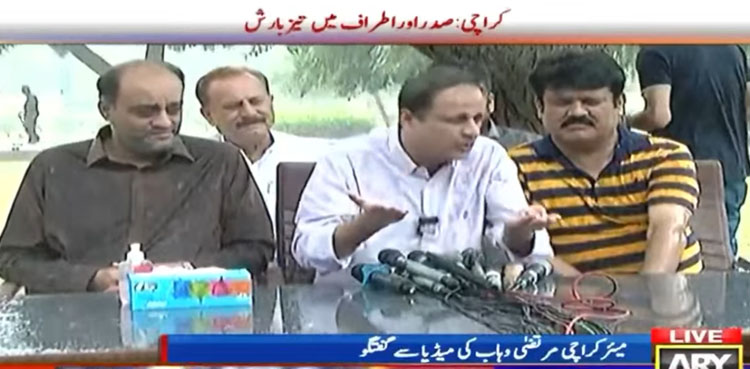KARACHI: Mayor Murtaza Wahab said that Karachi witnessed devastating rainfall on Monday, with record downpours recorded across the city, ARY News reported.
In a press conference, Murtaza Wahab noted that the destruction caused by rain was not limited to Karachi alone, but was also seen in several districts of Khyber Pakhtunkhwa, Gilgit-Baltistan, Azad Kashmir, and Punjab.
He said Pakistan has two options in the face of climate change: either adapt or resort to criticism.
According to Wahab, the first spell of rain in Karachi ended around 12:30 pm, while the second spell began at 1:30 pm and continued non-stop for five hours until 6 pm. Heavy rain eased after 6 pm, and by around 8 pm, rainfall had stopped across most parts of the city.
Manghopir received the highest rainfall at 235 mm, followed by Gulshan-e-Hadeed at 202 mm and Karachi Airport at 200 mm.
Across the city, 175–235 mm of rainfall was recorded within 12 hours. Wahab explained that Karachi’s storm drains can only handle up to 40 mm of rainfall.
Any amount above this leads to overflow. The largest overflows occurred at three points along Shahrah-e-Faisal.
Wahab said that during his press briefing, fresh rain began in the city. He added that Chief Minister Sindh had personally visited the affected areas by car at 11 pm, including Shahrah-e-Faisal and Nursery, where two storm drains pass.
By that time, water had been cleared from Shahrah-e-Faisal, Nursery, Tipu Sultan, and nearby areas. Similarly, Shahrah-e-Pakistan, Shahrah-e-Sher Shah Suri, and Punjab Colony underpass had also been cleared.
The mayor urged citizens not to leave their homes unnecessarily during heavy rains for their own safety.
Also Read: Karachi rain exposes fragile city infrastructure
Earlier, the impact of Monday’s Karachi rain continues to disrupt daily life as key roads and underpasses remain damaged and unusable.
In Liaquatabad, a newly constructed road collapsed due to the Karachi rain, while large potholes appeared on the stretch from Liaquatabad Post Office to Sindhi Hotel. Restoration work on the road from the Post Office to Teen Hatti has not yet begun, leaving commuters in distress.
In Nazimabad, water could not be drained from the main underpass, while both tracks of the underpass near Sir Syed College are still unusable.
Meanwhile, the Karachi rain also turned Nipa Chowrangi into a pond-like situation, making traffic movement nearly impossible.
Citizens traveling from Safora to Hasan Square faced severe difficulties, as sanitation workers sitting nearby showed no willingness to clean up.
The rain in Karachi has once again exposed the fragile state of the city’s infrastructure and the lack of timely response from authorities.


Leave a Comment